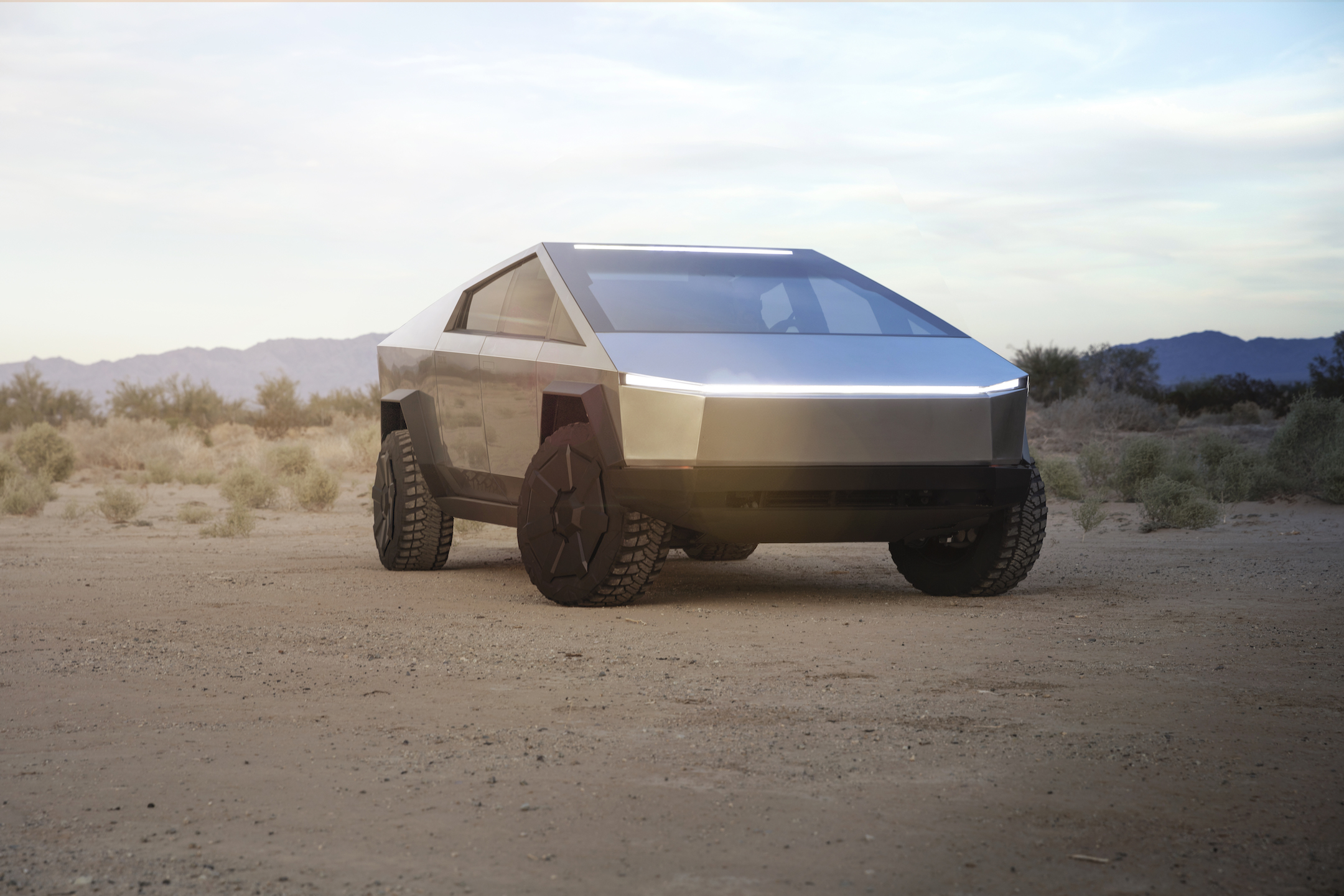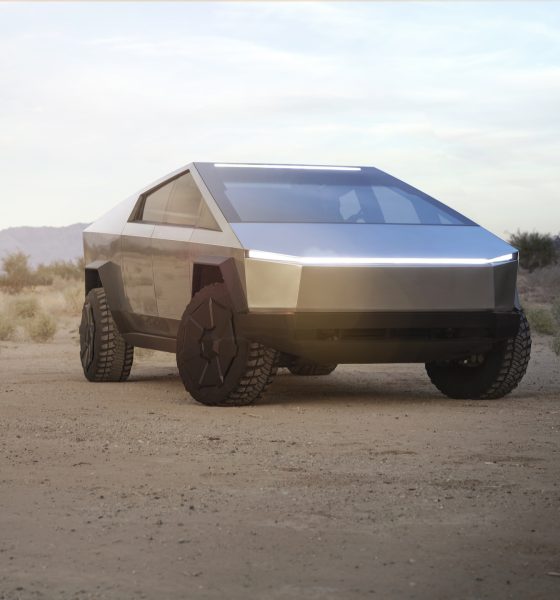

News
Tesla Cybertruck will have Elon Musk’s flamethrower as an option
Elon Musk has hinted on Twitter that the infamous Boring Company “Not-a-Flamethrower” may be included as an option for the newly released Tesla Cybertruck.
The popular post-apocalyptic theme television program The Walking Dead posted a tweet identifying the Cybertruck as a prime candidate for the perfect vehicle to use in the event of a zombie apocalypse. And who could argue? The truck would not dent or break in the event of a zombie takeover. The truck’s durability was displayed during its unveiling event on November 21, where Tesla designer Franz von Holzhausen slammed into the driver’s side door with a sledgehammer. The truck would more than likely get the driver and its 5 other passengers several hundred miles away, especially if the Tri-Motor variant with a 0-60 MPH time of 2.9 seconds and 500+ miles of range is being used.
Musk entertained the idea of the truck being beneficial for evading capture from the rising dead and offered an extra bit of assistance from his past Boring Co. project, the “Not-a-Flamethrower.”
The finest in apocalypse protection technology! Flamethrower optional.
— Elon Musk (@elonmusk) November 27, 2019
Musk said on an episode of the Joe Rogan Experience that his Boring Company created the 20,000 Flamethrowers (that sold out in four days) as an “off-the-cuff idea” inspired by the movie Spaceballs. The 1987 film that has been a driving factor behind some of Musk’s high-performance powertrains like Ludicrous Mode and the yet-to-be-released Plaid Mode, was also behind the (Not-a-)Flamethrower. “Yogurt (a character in Spaceballs) goes through the merchandising section, and there’s a Flamethrower…and we said ‘we should do a flamethrower,” Musk said during his interview with Joe Rogan.
While the Not-a-Flamethrower sold out extremely quickly, the name was given to it so international customs agencies could not deny delivery of the modified roofing torch to buyers located outside of the United States. While the Boring Company does not have Flamethrowers available for purchase through its website, it can be found on eBay and they vary in price. We know there is still interest in the Flamethrower, especially from UFC Star Conor McGregor, who recently requested two of them with his Cybertruck pre-order.
While we don’t know if Musk is serious about adding this feature to the Cybertruck, we have learned in the past to never count his ideas out, even if they may seem far fetched and somewhat outlandish. He’s added some extremely unique features for Tesla vehicles, like his hilarious references to “Toilet Humor,” which eventually resulted in the Emissions Testing Mode Easter Egg. After all, the man did invent a Flamethrower to begin with, so who is to say he won’t add it as an optional feature with the all-new Cybertruck.
You can watch Elon Musk talk about his “Not-a-Flamethrower” on the Joe Rogan Experience below.

News
Tesla starts showing how FSD will change lives in Europe
Local officials tested the system on narrow country roads and were impressed by FSD’s smooth, human-like driving, with some calling the service a game-changer for everyday life in areas that are far from urban centers.

Tesla has launched Europe’s first public shuttle service using Full Self-Driving (Supervised) in the rural Eifelkreis Bitburg-Prüm region of Germany, demonstrating how the technology can restore independence and mobility for people who struggle with limited transport options.
Local officials tested the system on narrow country roads and were impressed by FSD’s smooth, human-like driving, with some calling the service a game-changer for everyday life in areas that are far from urban centers.
Officials see real impact on rural residents
Arzfeld Mayor Johannes Kuhl and District Administrator Andreas Kruppert personally tested the Tesla shuttle service. This allowed them to see just how well FSD navigated winding lanes and rural roads confidently. Kruppert said, “Autonomous driving sounds like science fiction to many, but we simply see here that it works totally well in rural regions too.” Kuhl, for his part, also noted that FSD “feels like a very experienced driver.”
The pilot complements the area’s “Citizen Bus” program, which provides on-demand rides for elderly residents who can no longer drive themselves. Tesla Europe shared a video of a demonstration of the service, highlighting how FSD gives people their freedom back, even in places where public transport is not as prevalent.
What the Ministry for Economic Affairs and Transport says
Rhineland-Palatinate’s Minister Daniela Schmitt supported the project, praising the collaboration that made this “first of its kind in Europe” possible. As per the ministry, the rural rollout for the service shows FSD’s potential beyond major cities, and it delivers tangible benefits like grocery runs, doctor visits, and social connections for isolated residents.
“Reliable and flexible mobility is especially vital in rural areas. With the launch of a shuttle service using self-driving vehicles (FSD supervised) by Tesla in the Eifelkreis Bitburg-Prüm, an innovative pilot project is now getting underway that complements local community bus services. It is the first project of its kind in Europe.
“The result is a real gain for rural mobility: greater accessibility, more flexibility and tangible benefits for everyday life. A strong signal for innovation, cooperation and future-oriented mobility beyond urban centers,” the ministry wrote in a LinkedIn post.
News
Tesla China quietly posts Robotaxi-related job listing
Tesla China is currently seeking a Low Voltage Electrical Engineer to work on circuit board design for the company’s autonomous vehicles.

Tesla has posted a new job listing in Shanghai explicitly tied to its Robotaxi program, fueling speculation that the company is preparing to launch its dedicated autonomous ride-hailing service in China.
As noted in the listing, Tesla China is currently seeking a Low Voltage Electrical Engineer to work on circuit board design for the company’s autonomous vehicles.
Robotaxi-specific role
The listing, which was shared on social media platform X by industry watcher @tslaming, suggested that Tesla China is looking to fill the role urgently. The job listing itself specifically mentions that the person hired for the role will be working on the Low Voltage Hardware team, which would design the circuit boards that would serve as the nervous system of the Robotaxi.
Key tasks for the role, as indicated in the job listing, include collaboration with PCB layout, firmware, mechanical, program management, and validation teams, among other responsibilities. The role is based in Shanghai.
China Robotaxi launch
China represents a massive potential market for robotaxis, with its dense urban centers and supportive policies in select cities. Tesla has limited permission to roll out FSD in the country, though despite this, its vehicles have been hailed as among the best in the market when it comes to autonomous features. So far, at least, it appears that China supports Tesla’s FSD and Robotaxi rollout.
This was hinted at in November, when Tesla brought the Cybercab to the 8th China International Import Expo (CIIE) in Shanghai, marking the first time that the autonomous two-seater was brought to the Asia-Pacific region. The vehicle, despite not having a release date in China, received a significant amount of interest among the event’s attendees.
Elon Musk
Elon Musk and Tesla AI Director share insights after empty driver seat Robotaxi rides
The executives’ unoccupied tests hint at the rapid progress of Tesla’s unsupervised Robotaxi efforts.

Tesla CEO Elon Musk and AI Director Ashok Elluswamy celebrated Christmas Eve by sharing personal experiences with Robotaxi vehicles that had no safety monitor or occupant in the driver’s seat. Musk described the system’s “perfect driving” around Austin, while Elluswamy posted video from the back seat, calling it “an amazing experience.”
The executives’ unoccupied tests hint at the rapid progress of Tesla’s unsupervised Robotaxi efforts.
Elon and Ashok’s firsthand Robotaxi insights
Prior to Musk and the Tesla AI Director’s posts, sightings of unmanned Teslas navigating public roads were widely shared on social media. One such vehicle was spotted in Austin, Texas, which Elon Musk acknowleged by stating that “Testing is underway with no occupants in the car.”
Based on his Christmas Eve post, Musk seemed to have tested an unmanned Tesla himself. “A Tesla with no safety monitor in the car and me sitting in the passenger seat took me all around Austin on Sunday with perfect driving,” Musk wrote in his post.
Elluswamy responded with a 2-minute video showing himself in the rear of an unmanned Tesla. The video featured the vehicle’s empty front seats, as well as its smooth handling through real-world traffic. He captioned his video with the words, “It’s an amazing experience!”
Towards Unsupervised operations
During an xAI Hackathon earlier this month, Elon Musk mentioned that Tesla owed be removing Safety Monitors from its Robotaxis in Austin in just three weeks. “Unsupervised is pretty much solved at this point. So there will be Tesla Robotaxis operating in Austin with no one in them. Not even anyone in the passenger seat in about three weeks,” he said. Musk echoed similar estimates at the 2025 Annual Shareholder Meeting and the Q3 2025 earnings call.
Considering the insights that were posted Musk and Elluswamy, it does appear that Tesla is working hard towards operating its Robotaxis with no safety monitors. This is quite impressive considering that the service was launched just earlier this year.








